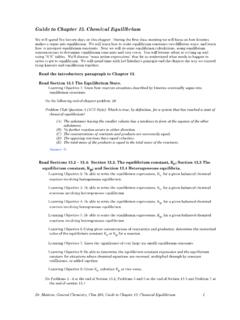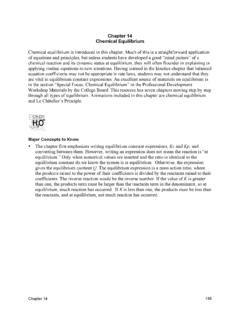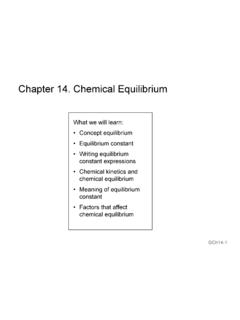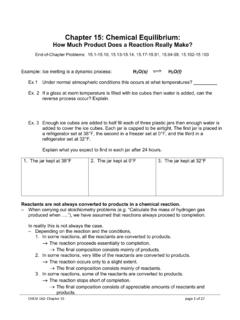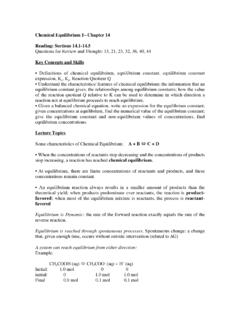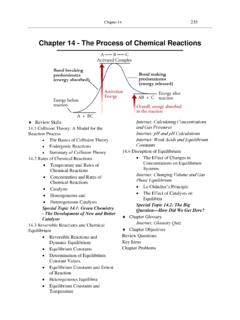Transcription of Chapter 14 Equilibrium - Crestwood Middle School
1 Copyright by Holt, Rinehart and Winston. All rights reserved. Resources Chapter menu Completion Reactions and Reversible Reactions If enough oxygen gas is provided for the following reaction, almost all of the sulfur will react: S8(s) + 8O2(g) 8SO2(g) Reactions such as this one, in which almost all of the reactants react, are called completion reactions. In other reactions, called reversible reactions, the products can re-form reactants. Section 1 Reversible Reactions and Equilibrium Chapter 14 Copyright by Holt, Rinehart and Winston. All rights reserved. Resources Chapter menu Completion Reactions and Reversible Reactions, continued Reversible Reactions Reach Equilibrium One reversible reaction occurs when you mix solutions of calcium chloride and sodium sulfate. CaCl2(aq) + Na2SO4(aq) CaSO4(s) + 2 NaCl(aq) The net ionic equation best describes what happens.
2 Section 1 Reversible Reactions and Equilibrium Chapter 14 aq aq s22-44Ca ()SO ()CaSO ( )Copyright by Holt, Rinehart and Winston. All rights reserved. Resources Chapter menu Completion Reactions and Reversible Reactions, continued Reversible Reactions Reach Equilibrium , continued Solid calcium sulfate, the product, can break down to make calcium ions and sulfate ions in a reaction that is the reverse of the previous one. Section 1 Reversible Reactions and Equilibrium Chapter 14 s aq aq22-44 CaSO ( )Ca ()SO ()22-44Ca ()SO ()CaSO ( )aq aq s Use arrows that point in opposite directions when writing a chemical equation for a reversible reaction. Copyright by Holt, Rinehart and Winston. All rights reserved. Resources Chapter menu Completion Reactions and Reversible Reactions, continued Reversible Reactions Reach Equilibrium , continued The reactions occur at the same rate after the initial mixing of CaCl2 and Na2SO4.
3 The amounts of the products and reactants do not change. chemical Equilibrium is a state of balance in which the rate of a forward reaction equals the rate of the reverse reaction and the concentrations of products and reactants remain unchanged. Section 1 Reversible Reactions and Equilibrium Chapter 14 Copyright by Holt, Rinehart and Winston. All rights reserved. Resources Chapter menu Completion Reactions and Reversible Reactions, continued Opposing Reaction Rates Are Equal at Equilibrium The reaction of hydrogen, H2, and iodine, I2, to form hydrogen iodide, HI, reaches chemical Equilibrium . Section 1 Reversible Reactions and Equilibrium Chapter 14 22H ( )I ( )2HI( )g g g Only a very small fraction of the collisions between H2 and I2 result in the formation of HI. H2(g) + I2(g) 2HI(g) Copyright by Holt, Rinehart and Winston.
4 All rights reserved. Resources Chapter menu Completion Reactions and Reversible Reactions, continued Opposing Reaction Rates Are Equal at Equilibrium , continued After some time, the concentration of HI goes up. As a result, fewer collisions occur between H2 and I2 molecules, and the rate of the forward reaction drops. Similarly, in the beginning, few HI molecules exist in the system, so they rarely collide with each other. Section 1 Reversible Reactions and Equilibrium Chapter 14 Copyright by Holt, Rinehart and Winston. All rights reserved. Resources Chapter menu Completion Reactions and Reversible Reactions, continued Opposing Reaction Rates Are Equal at Equilibrium , continued As more HI molecules are made, they collide more often and form H2 and I2 by the reverse reaction. 2HI(g) H2(g) + I2(g) The greater the number of HI molecules that form, the more often the reverse reaction occurs.
5 Section 1 Reversible Reactions and Equilibrium Chapter 14 Copyright by Holt, Rinehart and Winston. All rights reserved. Resources Chapter menu Rate Comparison for H2(g) + I2(g) 2HI(g) Section 1 Reversible Reactions and Equilibrium Chapter 14 Copyright by Holt, Rinehart and Winston. All rights reserved. Resources Chapter menu Completion Reactions and Reversible Reactions, continued Opposing Reaction Rates Are Equal at Equilibrium , continued When the forward rate and the reverse rate are equal, the system is at chemical Equilibrium . If you repeated this experiment at the same temperature, starting with a similar amount of pure HI instead of the H2 and I2, the reaction would reach chemical Equilibrium again and produce the same concentrations of each substance. Section 1 Reversible Reactions and Equilibrium Chapter 14 Copyright by Holt, Rinehart and Winston.
6 All rights reserved. Resources Chapter menu chemical Equilibria Are Dynamic If you drop a ball into a bowl, it will bounce. When the ball comes to a stop it has reached static Equilibrium , a state in which nothing changes. chemical Equilibrium is different from static Equilibrium because it is dynamic. In a dynamic Equilibrium , there is no net change in the system. Two opposite changes occur at the same time. Section 1 Reversible Reactions and Equilibrium Chapter 14 Copyright by Holt, Rinehart and Winston. All rights reserved. Resources Chapter menu chemical Equilibria Are Dynamic, continued In Equilibrium , an atom may change from being part of the products to part of the reactants many times. But the overall concentrations of products and reactants stay the same. For chemical Equilibrium to be maintained, the rates of the forward and reverse reactions must be equal.
7 Arrows of equal length also show Equilibrium . Section 1 Reversible Reactions and Equilibrium Chapter 14 reac tan tsproducts Copyright by Holt, Rinehart and Winston. All rights reserved. Resources Chapter menu More Examples of Equilibria Even when systems are not in Equilibrium , they are continuously changing in order to reach Equilibrium . For example, combustion produces carbon dioxide, CO2, and poisonous carbon monoxide, CO. After combustion, a reversible reaction produces soot. Section 1 Reversible Reactions and Equilibrium Chapter 14 22CO( )C( )CO ( )g s g This reaction of gases and a solid will reach chemical Equilibrium . Equilibria can involve any state of matter, including aqueous solutions. Copyright by Holt, Rinehart and Winston. All rights reserved. Resources Chapter menu chemical Equilibria Are Dynamic, continued In some cases, the Equilibrium has a higher concentration of products than reactants.
8 This type of Equilibrium is also shown by using two arrows. Section 1 Reversible Reactions and Equilibrium Chapter 14 reac tan tsproducts The forward reaction has a longer arrow to show that the products are favored. Copyright by Holt, Rinehart and Winston. All rights reserved. Resources Chapter menu More Examples of Equilibria, continued Equilibria Involving Complex Ions Complex ion, or coordination compound, is the name given to any metal atom or ion that is bonded to more than one atom or molecule. Some ions have a metal ion surrounded by ligands, molecules or anions that readily bond to metal ions. Complex ions may be positively charged cations or negatively charged anions. Section 1 Reversible Reactions and Equilibrium Chapter 14 Copyright by Holt, Rinehart and Winston. All rights reserved. Resources Chapter menu More Examples of Equilibria, continued Equilibria Involving Complex Ions, continued In this complex ion, [Cu(NH3)4]2+, ammonia molecules bond to the central copper(II) ion.
9 Section 1 Reversible Reactions and Equilibrium Chapter 14 Copyright by Holt, Rinehart and Winston. All rights reserved. Resources Chapter menu More Examples of Equilibria, continued Equilibria Involving Complex Ions, continued Complex ions formed from transition metals are often deeply colored. Section 1 Reversible Reactions and Equilibrium Chapter 14 Copyright by Holt, Rinehart and Winston. All rights reserved. Resources Chapter menu More Examples of Equilibria, continued Equilibria Involving Complex Ions, continued Consider zinc nitrate dissolving in water: Section 1 Reversible Reactions and Equilibrium Chapter 14 2-3 23Zn(NO ) ( )Zn ()2NO ()s aq aq2-3 22243Zn(NO ) ( )4H O( )[Zn(H O) ] ()2NO ()s l aq aq In the absence of other ligands, water molecules bond with zinc ions. So, this reaction can be written: If another ligand, such as CN , is added, the new system will again reach chemical Equilibrium .
10 Copyright by Holt, Rinehart and Winston. All rights reserved. Resources Chapter menu More Examples of Equilibria, continued Equilibria Involving Complex Ions, continued Both water molecules and cyanide ions compete to bond with zinc ions, as shown in the equation below. Section 1 Reversible Reactions and Equilibrium Chapter 14 2 2 2442[Zn(H O) ] ()4CN ()[Zn(CN) ] ()4H O( )aq aq aq l All of these ions are colorless, so you cannot see which complex ion has the greater concentration. Copyright by Holt, Rinehart and Winston. All rights reserved. Resources Chapter menu More Examples of Equilibria, continued Equilibria Involving Complex Ions, continued In the chemical Equilibrium of nickel ions, ammonia, and water, the complex ions have different colors. You can see which ion has the greater concentration. Section 1 Reversible Reactions and Equilibrium Chapter 14 222633 62[Ni(H O) ] () 6NH ()[Ni(NH ) ] () 6H O( )aqaq aql green blue-violet The starting concentration of NH3 will determine which one will have the greater concentration.

